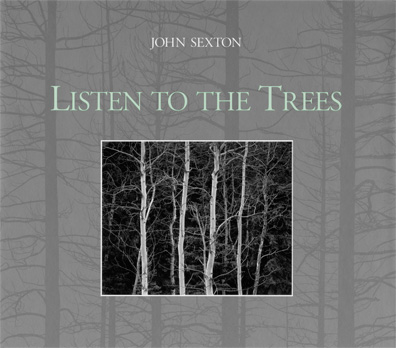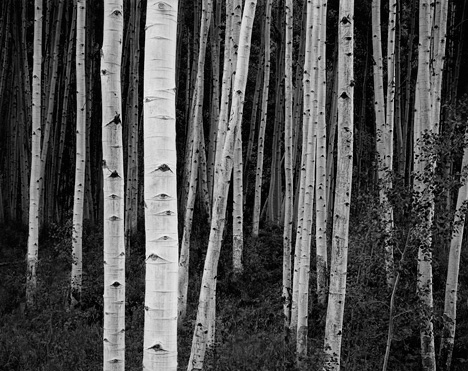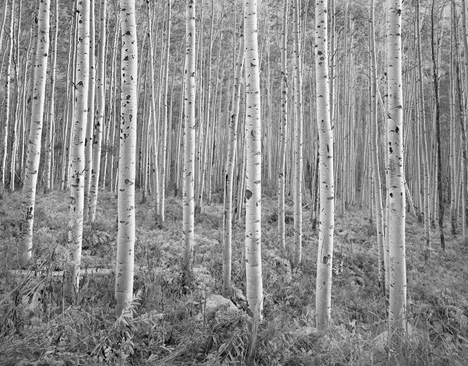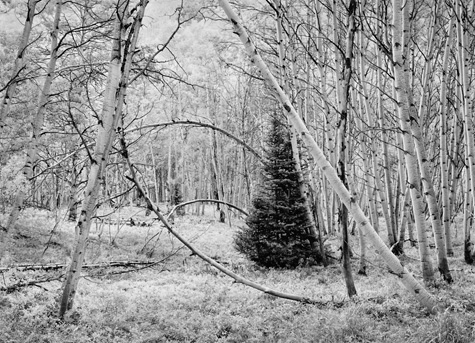|
LISTEN TO THE TREES
WITHIN THE FOREST
Aspen Forest, Dusk As I stand within an aspen grove in Castle Creek Valley, Colorado, I am reminded again of the rejuvenating quality of trees, how being surrounded by them can cleanse the mind, body, and soul of the distractions of what we call the real world. I am afraid that, as time has passed, what we accept as the real world has become distorted. As I wander with my camera in this beautiful stand of aspens, it is clear to me the real world is right here. The real world is within the natural environment, and for me one place to find the real world is within the forest. Forests are sanctuaries. This aspen forest is like a room, with luminous white trunks for walls. I find myself looking upward to the green leaves quaking in the wind... toward the ceiling of thunderclouds passing by. In the distance thunder rolls through the valley... the sound of birds singing within the forest mingles with the remote whisper of a creek as it rushes over the rocks in its path. The forest creates an envelope like a protective cocoon. I feel at one with the trees, more comfortable among hundreds of them than in a group of people. And as with people, trees have body language. Each tree is unique, has its own posture and gesture. Each has a quality that makes it an individual. As I stand here raindrops begin to fall from my ceiling of sky. Soon, the trunks that form the walls of my room will change their character, as moisture begins to streak down them, altering the quality of their surfaces, altering the way they reflect light. During photographic workshops I have been asked what makes me stop and make a photograph. For me, with any subject it is the quality of light. It is a question of whether the light reveals or obscures the personality, the shape, the individuality of the tree. In the delicate light of this misty rain, the trees seem to glow as if illuminated from within. For me, then, the challenge becomes finding a group of trees that seem to relate to one another. I am not often drawn to photograph a stand of trees in the distance, but would rather be within the forest, surrounding myself, and the viewer, with my woodland walls. As I look out the windows of my tree house, I see blue spruce, I see pine trees among the aspens, and I hear the leaves flutter as their trunks move gently and smoothly in the wind. I feel at home here, I feel at peace, I feel as if I have been delivered from those distractions we accept as the real world. – John Sexton
A CELEBRATION OF TREES
Glowing Aspens Over the course of a lifetime, a person who spends time with trees acquires odd bits of knowledge, curious cuttings to treasure. For example, in certain aspen groves the trunks are as smooth as an infant’s skin, an analogy made more vivid by the talc like powder the bark deposits on a caressing hand. This is the sort of thing John Sexton knows, for trees are his intimate companions, the forest his special haunt. If to be among trees is a privilege, then this man has been exceptionally blessed. The photographs he has collected here are the product of patient stalking, days and months of quiet waiting. The truth is, trees are shy; they reveal their essence rarely. To capture those moments on film takes endless perseverance and prodigious labor. What you don’t see in these pages is the trudge with heavy tripod, the muddy boots, the parka drenched in a sudden thunderstorm, the hours of darkroom toil. What you do see is the result: exquisite images speaking in myriad tongues of beauty. An artist who worships at the altar of light, John Sexton complements and extends the work of his mentor, the late Ansel Adams. And if Adams’s first love was the expansive, majestic landscape, Sexton is fascinated by what quiet light does to reveal and transform Earth’s more intimate handiwork. His effort to document those glories has produced this forest of images, this album of trees, twenty painstaking years in the making. In his abiding belief that trees are a wellspring of inspiration, Sexton surely agrees with Robert Frost, our greatest pastoral poet, that “the thing that art does for life is to clean it, to strip it to form.” Indeed, the insights of these two artists merge in Frost’s memorable verse, which I’ve long treasured.
It is that ancient kinship between humans and trees that this book seeks to rekindle. For at least two million years, or since Homo sapiens first appeared among the scattered acacias on an African savannah, our connection with trees has coursed through three channels: utilitarian, ecological and spiritual. Most people have some appreciation for trees’ usefulness, as symbolized by the ubiquitous two-by-four stud and number two pencil. Nonetheless, rarely do we reflect on what life might be like in their absence. Trees are our omnipresent companions. I sit writing this morning in my kitchen, where the table is oak, the floor is fir, the chair is pine. The viga overhead is spruce, the wood stove fueled by juniper. There are also the newspaper, the apple, the coffee, the orange juice—even the pancake syrup. We lean on trees all our lives. From the moment we are conceived, often on a wooden bed, to the moment we are buried, sometimes in a wooden box, trees are our cane and our canopy. If trees’ utilitarian merits are insufficiently appreciated, their ecological value is all but ignored. Trees shelter the animals, temper the weather, sieve the winds, store the rain. Exhaling oxygen, trees fill the world’s lungs, and so make life possible. Unconvinced? Hike across a shadeless desert. Or climb above the timberline, where wind and frost rule. A world without trees? That’s the Arctic, the Sahara. A world without trees? Where would birds sing? Our connection with trees is also spiritual, an embodiment of grace. This, too, has distant roots. Many so-called primitive cultures worshiped trees. Some believed, as Navajo elders still do, that trees are manifested gods. Similar beliefs show up early in western civilization and in the major religions. More than two thousand years ago, the Romans were protecting hallowed groves and Buddha sought enlightenment beneath a Bodhi tree. In Deuteronomy an Old Testament prophet enjoined warriors to spare the enemy’s fruit trees even while laying siege to their cities. And the Garden of Eden was, after all, not a garden but a forest. That trees are both beautiful and a source of inspiration and rejuvenation is a venerable truth that the advent of industrialism has frayed but not broken. We still decorate trees at Christmas, still plant a tree to celebrate a birth or commemorate a death. Against all odds, the love of trees endures. In his title Sexton bids us “listen to the trees.” This poses a conundrum: How do we listen to a tree? If trees are not mute—they creak and shudder in the wind—they certainly speak no known tongue. Sexton listens through the camera lens. But what of the rest of us? Should we listen with our eyes? Ears? Hands? Considering that puzzle, we encounter another: Once listening, what are we listening for? By raising these questions, I do not mean to play word games or engage in mysticism. I am no Druid. In my opinion the colloquy between humans and trees is perfectly straightforward. We listen to trees by paying attention to them. By heeding their grace. And, above all, by appreciating what they add to our lives. Appreciation, that’s the key. Trees are immensely generous. They do not ask us for anything. Rather, they are content to give and give—and give some more. But if all we humans do is take, after a while our kinship with trees becomes girdled, is whittled back to a stump. The essential conversation we have with trees is not so much a path for discussion as it is an avenue for gratitude, a channel for thanksgiving. Without consciously thinking about it, I’ve been listening to trees all my life. Seventy-four years ago I was born in the heart of piñon-juniper country. These gnarled evergreens blanket hundreds of thousands of square miles in the Southwest, and as a boy I soon learned that the knotty wood of both trees would quickly dull an ax. Desert trees—the green-skinned paloverde and the bean-clad mesquite—came next in my arboreal odyssey, and then I moved east to the land of thick boles and broad leaves. Accustomed to dwarfs, I was shocked by the towering giants around Washington, D.C., but eventually grew to cherish their emerald embrace. On weekends I would sometimes lie on the deck at my home near the Potomac River and watch squirrels racing through the canopy 150 feet overhead, fearlessly catapulting themselves from branch to branch. After two decades my course wound west again, first to Phoenix, where my backyard companions were citrus, then to Santa Fe, where I’m once more feeding fires with piñon and juniper, inhaling their sweet incense, cursing their stubborn refusal to be split. As I write, I gaze out upon a gnarled piñon almost close enough to touch. Although the tree is only about fifteen feet tall, this stony ground suggests it is older than I. A few years ago, when we were preparing to excavate the foundation for this house, the piñon’s shadow fell within the lines. Convenience argued for felling it. I flagged it instead, instructing the backhoe operator to protect it at all costs. If saved, the piñon, I knew, would be a trusty companion during my last years, a welcome “window tree.” Each of us would do well, I think, to seek out such companions and to practice a bit of silviculture, if only in amateur fashion. In its humble, Saturday morning, tennis-shoes-and-jeans simplicity, the planting of trees is one of the most dignified, even exalted, rituals we can perform. Since the condition of a nation’s forests is a measure of its wealth, it pleases me to report that more than three billion trees are being planted each year in this country, many of them by some five hundred nonprofit organizations that have sprung up to reinvigorate our urban forests. Our national forests—some of which were being pillaged as recently as a few years ago—are also on the mend. With the help of schoolchildren, Arbor Day is making a comeback, while the concept of sustainable forestry, forestry for the ages, is rapidly gaining ground. An idea advocated by deep ecologists and once considered radical—that the needs of the tree are the needs of the person—is beginning to seem like common sense. Environmental laws passed in recent years have given our nation’s forests new legal standing. In a sense, trees now have rights. Unfortunately, as some forestry practices improve, those in many places continue to deteriorate. Everyone knows what is happening, and I will not belabor it here. In India, Thailand, Malaysia, Nepal, Brazil, and almost every other developing country, forests are being decimated. Great swaths of trees all across Europe have been weakened or killed by acid rain. Meanwhile, the forest slayers have set their sights on virgin Siberia. This assault can’t continue much longer. And when it ends—either because the trees have all been toppled or because logic prevails over greed—forest restoration will be an essential task in the healing of the planet. Today’s young people will, I predict, witness the birth of a tree culture that will dwarf any the world has ever seen. Within a few decades, if not sooner, untold millions of human beings will literally be planting trees as if their lives depend on it, which, of course, they will. Against that confused thicket of good and bad news, this celebration of trees could not be more timely. What John Sexton has accomplished in these pages is a marvelous feat of alchemy. We routinely make trees into paper. He, though, has done the reverse: magically transformed paper—and recycled paper, at that—back into the sinuous, swaying wonder it originally was. In this album he invites us to explore his sacred groves, to rediscover the beauty of the woods, and to learn once more that trees are the best companions we have. – Stewart L. Udall Stewart L. Udall served in the House of Representatives from 1955 to 1961. He was appointed Secretary of the Interior by President John F. Kennedy in 1961, and continued in that post until 1969. Udall is the author of many books, including The Quiet Crisis and the Next Generation and To the Inland Empire: Coronado and Our Spanish Legacy. A lifelong conservationist, Secretary Udall passed away in 2010. He leaves behind a rich legacy of protection of our public lands and fragile planet.
THE DIALECT OF TREES
Aspen Dream Our existence is inexorably bound to trees. They bind earth and air in a perpetual union that sustains us. Trees shelter and permeate Earth’s skin. Conceived before humankind, they are destined to outlast us. They embrace us from cradle to coffin, shade us in summer, warm us in winter. We burn their wood, wander lost in thought among them, follow them to water in the desert, and mark the cycle of our years by their budding and falling leaves. When we are young, we swing from their limbs; when we die, a tree is planted to honor our memory. How can we honor the existence of trees? For most of us nature remains a constant yet undecipherable backdrop to daily life. Culture has driven us so far from nature, explains poet and ecologist Gary Snyder, “we don’t even know that we don’t even know nature’s language.” Desiring communion with nature, artists and naturalists such as John Sexton honor their subject with deep recognition, using their work to explore their relation to nature. By working close to nature, John has begun to learn its vocabulary. He has come to recognize that his perceptions are formed through interaction with his subject, and to accept that his communion with nature is achieved by clarifying the bond between his internal life and the external world. John’s most profound relationships with nature developed in the places he knows best, places to which he returns each year: stands of trees in Yosemite National Park, the Castle Creek Valley near Aspen, and the land near his home in Carmel Valley, California. He recalls having wandered, as a young child, from his parent’s campsite in Yosemite Valley, and finding himself lost among the vast and imposing trees. His family vacationed in Yosemite each summer, and with repeated visits John came to discover not so much its grand vistas as the intimate forest landscapes along the valley floor. Now, in middle age, walking within those same groves, he talks about them as being protective, comforting, and rejuvenating. John begins to photograph slowly. Isolated from the world he studies the projection of a tree on the ground glass of his camera. He focuses on revealing details: the gesture of limbs, the embrace of fallen trunks, the texture of bark. As an image a tree can become many things, things as diverse as a symbol of joy or dread, an advertisement for utility, or a configuration of black and gray tones. More important, it can become an embodiment of itself, a potent rendering of a living being. Projection on the ground glass is the first step in its metamorphosis into a personal expression. In encountering a tree, John hopes, through the fidelity of his attention to its expressive qualities, to make pictures that evoke the idea of treeness. Looking at his work, you might think his camera has been the catalytic element in an alchemical process wherein ordinary, underappreciated subjects are converted into something valuable: silver images. But, while working in the landscape, photographers such as John have come to appreciate that a more profound event occurs. Though it appears that, in making an image, the photographer is drawing meaning out of the subject, in actuality the subject is teaching the photographer. Mentored by their interaction with the landscape, these artists are apprenticing with nature. John made the photograph Aspen Dream (plate 6) his first morning in a now-favorite grove in Castle Creek Valley. Photographing those trees, he felt the smooth, creased bark and stored that sensation in memory. Later, in the darkroom, his impression entered the image through the selection of printing paper and developer, through choices about darkening and lightening the print, reducing or increasing the contrast. Thus, something of the character of the trees combined with John’s experience of them to form the image on paper. He had, as he says, “created an illusion of the sensory phenomena I experienced in the forest.” But a photograph sometimes appears also to have captured some residue of its subject. Photographer and teacher Minor White, addressing this metaphysical quality of photographs, spoke about particles from the subject, ignited as photons, passing through the camera lens and intermingling with the film emulsion. That is, the trees literally enter the image. In Aspen Dream we can also glimpse nature’s language. To the uninitiated viewer the connection between the picture and the place it was made is not at first apparent. Each viewer familiar with the dialect of the locale, however, can add a layer of meaning beyond the pictorial qualities of the photograph. For instance, if it were possible to go back in time and show this image to a Ute Indian who once lived in what is now Aspen, Colorado, that person might determine from the evidence that this area was an uncertain hunting ground: the tree trunks are unblemished by the signature markings of wildlife. Today, a botanist might discern, even without reading the title, that this image was made in the Colorado mountains between the elevations of seven and ten thousand feet, which is where aspens thrive in their purest, densest stands. This scientist might deduce that a climax forest, probably about the end of the nineteenth century, had been burned or logged off—as aspens are the first to move into cleared mountain slopes in the region. The appearance of spruce, the botanist might also note, indicates that in time these conifers will multiply, shade out, and succeed the aspen. John responded to the ethereal illumination of this scene and brought his own insights to the reading of the locale and of nature’s patterns overall. Thus, in this photograph the arcing aspen trunks mimic the stylized outline of the spruce. If forests are fraught with mythic dangers, by contrast their individual members—the trees—have been universally revered. In Romanesque art trees were rooted in the underworld, their trunks grew up into the living world, and their branches formed the pillars of heaven. Among native cultures worldwide and throughout history, trees have been portrayed as our ancestors, thus honoring their anthropomorphic qualities of standing, reaching out, and growing. Trees have also been thought to have consciousness as well as the ability to sing or reveal secrets. Druids believed different kinds of tree leaves stood for different letters, and their ordering spelled out secret messages. In one Asian myth each leaf of the Tree of Life had a special word written on it, a word obtained by a deceased person and used as a personal mantra before he or she could be reborn into this world. In the ancient practice known as phyllomancy, messages could be divined by interpreting the sound of rustling leaves, especially the distinctive trembling of the aspen’s. Today, photographs augment ancient myths and, in effect, create new ones about our relationship with nature. As an example, landscape photographs have transformed our perception of the American West, previously thought of as a wasteland, now considered a place of beauty and reverence. To the eyes of early European travelers, the region was inhospitable and desolate. When artists such as Albert Bierstadt first interpreted this landscape, they often imposed European standards of beauty on it, painting misty, verdant scenes of what was in reality a stark land. Eventually, the West attracted interpreters responsive to its sharp light, extreme views, and unfoliated terrain, including photographers William Henry Jackson and Timothy O’Sullivan. Their work developed a new sensibility in us for this wild country and, in so doing, helped preserve it. In 1879 Jackson’s photographs of this geologic wonderland convinced Congress to establish Yellowstone National Park. In the 1960s the Sierra Club produced books featuring the works of Ansel Adams, Philip Hyde, Eliot Porter, and others whose work transformed the barren rock and clay of the West into emphatic forms of power and meaning, and created a new aesthetic of appreciation. While forwarding the cause of legislated wilderness preservation, these books and photographs persuaded individual readers to respect the intrinsic value of the land, becoming guidebooks not only to new places but to new attitudes. John sees his work, in part, as a continuation of this tradition, encouraging belief in the immanent value of trees, not for their utility, but for their significance as sentient beings. In our attempt to reconnect with the natural world, we confront the myth of our individuality. Ultimately, what separates us from nature is our belief that perception and expression are the products of “personal experience.” In particular, when artists claim the creative act as their own, they—and their viewers—are carried away from a sense of wholeness with the world around them. Naturalist-writer David Abram proposes we shift “the locus of creativity from the human intellect to the enveloping world itself. The creation of meaning, value, and purpose is no longer accomplished by a ghostly subject hovering inside the human physiology.” Our minds are not divorced from our bodies, and our bodies are intricately interwoven with our surroundings. The air we breathe, the stimulation of our senses, the animals and plants we eat, even the trees we cherish are all part of our origins, part of what sustains us, and part of who we are. Creativity is not a possession; it is the interchange between ourselves and our world. Instinctively, we know communication is communion, and in the deepest sense we are inexorably bound not only to the trees, but to the rocks, the air, the water—to everything in the world around us. With this understanding we can recognize John’s photographs for what they are: collaborations with nature—an active, creative, sentient nature constantly exclaiming itself to those who listen. – James Baker James Baker is currently Executive Director of the Pilchuck Glass School in Seattle and Stanwood, Washington. He recently served as President of Maine College of Art in Portland, Maine (2006-2010). Previously he was Executive Director of Anderson Ranch Arts Center in Snowmass Village, Colorado (1995-2006). In 1973, Baker received his undergraduate degree in Meteorology from The Pennsylvania State University. In 1975, he earned a Master of Fine Arts degree in photography from the Rhode Island School of Design. He served as an Assistant Professor of Art (tenured) at Edinboro University of Pennsylvania (1975-1986) and as an Associate Professor of Arts and Humanities (tenured) at the University of Texas at Dallas (1981-1986). In 1986, he accepted the position of Program Director for Photography at Anderson Ranch Arts Center and in 1995 was invited to serve as Executive Director. Nationally, Baker has served on the boards of the Society for Photographic Education, the Alliance of Artists Communities (chair 2004-2005), the Association of Independent Colleges of Art and Design and the Nominating Committee for the Glass Art Society. -----
|
|
|
|




